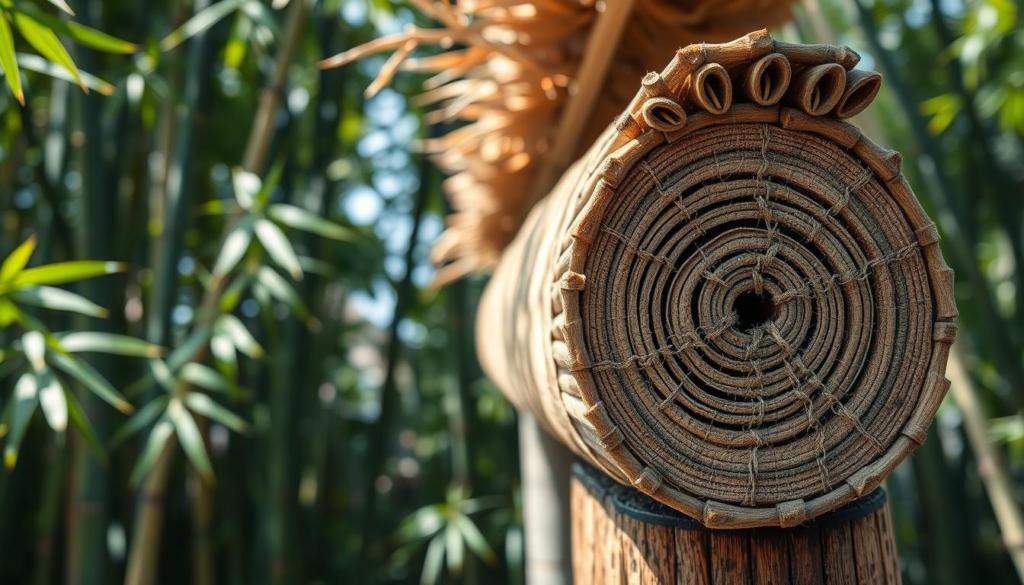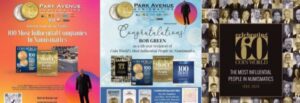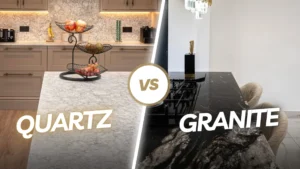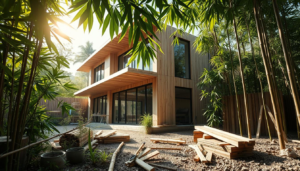Strand woven bamboo beam are perfect for modern construction work. They are known for being strong and eco-friendly. They make a great choice over the usual building stuff. Eco-friendly building materials like strand woven bamboo improve a building’s strength. They also make its carbon footprint smaller. This versatile material is good for many uses, including heavy timber building and fancy decorative work.
Key Takeaways
Strand woven bamboo beams are extremely durable and robust.
They are a highly sustainable and eco-friendly building material.
These beams are particularly suitable for heavy timber construction and decorative uses.
Produced through high-temperature carbonization and high-pressure hot pressing.
Dasso XTR and Renuteq are prominent brands in the bamboo building materials market.
The density and strength of strand woven bamboo surpass many traditional woods, scoring 3-4,000 on the Janka hardness scale.
What is Strand Woven Bamboo Beam?
Strand woven bamboo beam is a cutting-edge material known for its strength and eco-friendliness. It is made through a special process that boosts its physical qualities. This makes it different from ordinary bamboo products. By knowing how it’s made and what makes it special, we understand why it’s becoming a popular choice in building and design fields.
Manufacturing Process
Bamboo Beam Production starts with smashing bamboo strips into fibers. Then, these fibers are bonded with phenolic resin under high heat and pressure. This creates strong and dense beams. The machines used are huge, for example, one can be 2550*2600*5500mm in size and weigh 80 tons. They have the power to press with force up to 3500 tons. This allows producing 500 blocks a day for 20 hours. These production lines sell strand woven bamboo flooring worth around 0.3 billion dollars annually. Over 45 factories worldwide use this technology.

Unique Features
One key feature of Bamboo Beam Properties is its amazing strength, which is of the level of tropical hardwoods. Testing has shown these beams have high compressive and yield strengths. Their mechanical performance is strong because of their high compressive elastic modulus and a suitable Poisson’s ratio. Strand woven bamboo beams can be shaped and sized for various design needs. They are strong and withstand different kinds of stress, which makes them a great choice for many construction projects.
| Property | Measurement |
| Machine Size | 2550*2600*5500mm |
| Weight | 80 tons |
| Max Pressure | 3500 tons |
| Production Capacity | 500 PCS block/day per 20 hours |
| Peak Compressive Strength | 63.92 MPa |
| Yield Strength | 37.64 MPa |
| Compressive Elastic Modulus | 11684.36 MPa |
| Poisson’s Ratio | 0.39 |
Advantages of Strand Woven Bamboo Beam
Strand woven bamboo beams are remarkable for their strength, durability, and eco-friendliness. Their unique making process is gaining attention in building work. Let’s look at what makes these building materials so special.
High Density
Strand woven bamboo beams are known for their high density. They can be as dense as 1200kg/m3, much more than wood beams. Because of this, they’re stronger and less likely to swell or change shape over time. Compared to wood, bamboo’s swelling is tiny, only 0.4% in 24 hours.
Durability
These bamboo beams are incredibly tough, with a hardness over 2000 pounds. This exceeds many hardwoods such as walnut and oak. They can handle a lot of wear and tear, making them great for tough building projects. Also, they emit very low formaldehyde, safer for indoor air.
Eco-Friendliness
These beams are also great for the planet. Bamboo grows fast, and during manufacturing, over 90% of the material is used. This efficiency and renewability make them a smart choice for green building.
The beams are made with phenolic resin, making them strong and green. Using these bamboo beams helps in building a sustainable future. They’re not just durable, but also promote environmental care.
| Feature | Strand Woven Bamboo Beam | Traditional Wood Beam |
| Density (kg/m3) | 1200 | 750 |
| Thickness Swelling (%) | 0.4% | 2% |
| Formaldehyde Emission (mg/L) | 0.35 | 1.5 |
| Renewable Resource | Yes | No |
Comparing Strand Woven Bamboo and Engineered Bamboo Beams
Understanding the differences between Engineered Bamboo vs. Strand Woven Bamboo is key in eco-friendly building. Each has unique benefits, fitting various uses. We will compare their strengths, density, flexibility, and costs to highlight their construction roles.
Strength and Density
Strand Woven Bamboo beams are known for their outstanding strength and density. Their strength comes from a special process that compresses the bamboo. For example, Strand Woven Bamboo (SWB) beams are three times as hard as oak, great for heavy use.
These beams are significantly stiffer and stronger when reinforced, making them tougher by up to 2.9 and 2.3 times respectively. On the other hand, engineered bamboo beams are built with layers. They are strong but not as dense. Their structure is best for lighter tasks.
Flexibility and Cost
Engineered bamboo beams win in flexibility and cost. Their design lets them bend and flex, fitting a variety of designs without losing strength. This makes them a smart pick for projects needing adaptability.
Cost-wise, engineered bamboo is cheaper than strand woven bamboo. Its simpler production means lower prices. So, for projects on a budget, it’s a solid yet affordable option.
In the end, both Engineered Bamboo and Strand Woven Bamboo beams have their places. Strand Woven beams are denser and stronger. Engineered Bamboo beams, however, are more flexible and cost-effective. Both are valuable for sustainable construction, depending on the project’s demands.
Common Uses for Strand Woven Bamboo Beams
Strand woven bamboo beams are now a big hit in building work. They’re both versatile and good for the planet. These beams can do a lot, from holding up big projects to making places look better.
Structural Applications
Strand woven bamboo is strong, making it great for big building jobs. It’s used in things like bridges and large buildings. Some types are as dense as 1150kg/m³, which is as strong as some woods.
Companies like BWG and THJ make these beams to last. They say they can last more than 50 years. THJ beams are especially good because they bend well, don’t attract termites, and don’t burn easily.
| Criteria | THJ Outdoor Bamboo Beams | Other Wood Species |
| Density | 1.15-1.18 kg/m³ | Teak: Lower, Merbau: Lower |
| Moisture Rate | 8-12% | Varied |
| Hardness | 70.4 Gpa | Red Cedar: Lower, Jarrah: Lower |
| Durability | Over 25 years warranty | Varied |
| Anti-Corrosive Features | Excellent | Depends on species |
| Abrasion Resistance | Excellent | Varied |
Decorative Applications
These beams are not just for holding things up. They also make places look good. They’re used for things like window frames, door frames, and on walls. They add a fancy yet natural feel to both homes and businesses.
BWG and other companies can make beams in many colors and styles. This means they can fit right into any design while staying beautiful and useful for a long time.
Strand Woven Bamboo Beam in Heavy Timber Construction
Strand woven bamboo beams are changing heavy timber construction. They are strong and meet the need for sustainable materials. The push for eco-friendly building materials makes bamboo a top choice.
Bamboo beams have great physical features. For example, ANOS® beams are dense, have low moisture, and strong breaking strength. They’re perfect for big projects. Their durability and fire reaction rating make them ideal for homes and businesses.
Strand woven bamboo beams last over 50 years. This longevity is key in construction. They resist termites and don’t expand much in heat. These features make them excellent alternatives to timber.
BWG leads in making strand woven bamboo lumber. Their bamboo products, like pallets and beams, offer a strong option to hardwoods. Their bamboo mats are famous in Europe and North America for being hard, long-lasting, and affordable.
Using bamboo in construction reduces the carbon footprint of buildings. It offers durability and performance while being eco-friendly. This makes construction more sustainable for our planet.
Environmental Benefits of Using Strand Woven Bamboo
Using strand woven bamboo in construction has many environmental benefits. This bamboo is a sustainable resource, offering advantages over traditional materials. It’s known for its ecological positives.
Renewable Resource
Bamboo is a very renewable resource. Hardwood trees need up to 40 years to grow, but bamboo matures in 3 to 5 years. This means bamboo can be harvested over and over without harming its root system.
It quickly grows back after being cut, reducing the need for replanting. Hence, it lowers the rates of deforestation. Bamboo is a top choice for sustainable building thanks to this feature.
Carbon Footprint
Bamboo has a positive environmental impact, especially on the carbon footprint. It absorbs a lot of CO2 while growing, more than what’s released during production and transport. This helps fight climate change and keeps the environment healthy.
Its production uses eco-friendly resins and lower energy processes. This makes the carbon footprint smaller than traditional materials. Bamboo is key for green building due to these benefits. With a move towards eco-friendly building, the use of bamboo will grow.
Custom Sizes and Shapes for Various Projects
Bamboo beams are great for many projects. They work well inside or outside. They come in different lengths, widths, and thicknesses for any design.
Design Flexibility
Using Custom Bamboo Beams is smart because of their design flexibility. They can be straight, cambered, or curved for any project. This makes it easy to use them in various architectural designs. They add strength and beauty.
Big companies like ANOS® use high-tech methods to make these beams. They are strong and fit the project’s design needs perfectly.
Specific Project Requirements
Flexible Design Solutions make construction easier. You can get bamboo beams cut to the exact size you need. They come in many sizes.
Lengths go from 2440mm to 2000mm. Widths range from 1220mm to 600mm. You can choose thickness from 7mm to 40mm. This means builders and architects can find the right beams for any job, like roofing or window frames.
Strand Woven Bamboo Beam Installation Tips
Installing strand woven bamboo beams the right way is crucial. They offer great strength and beauty. Here are important tips for successful installation.
Letting bamboo beams adjust to their new environment is key. This step prevents warping. It also makes sure your structure lasts longer.
Avoiding common pitfalls associated with installing bamboo beams is achievable through comprehensive planning and careful execution.
When building with bamboo, consider the density of the material. You must pick fasteners that will hold the beams securely. Also, talking to experts can prevent mistakes and make your structure strong.
Environmental acclimatization – Ensure beams are exposed to local conditions before installation.
Appropriate fasteners – Use high-quality, compatible fastening systems to handle the density of bamboo.
Expert consultation – Leverage professional advice to circumvent installation mistakes.
Bamboo beams are strong and flexible. With a tensile strength of 28,000 pounds per square inch, they outperform steel. They also insulate well and resist earthquakes.
Here’s a brief overview of the installation process:
| Factors | Considerations | Benefits |
| Acclimatization | Expose to local conditions | Prevents warping, extends longevity |
| Fastening Systems | High-quality, compatible fasteners | Ensures secure installation, safety |
| Professional Advice | Consult experts | Avoids mistakes, enhances structural integrity |
Following these guidelines helps make your bamboo construction projects better and more lasting.
Conclusion
The use of strand woven bamboo beams in building marks a key step towards sustainability. These beams are as strong as steel and resist moisture better than traditional woods. This makes them a top choice for many building projects.
Looking ahead, bamboo’s future in construction looks bright. It grows super fast, up to 2.91 feet a day, and is ready for use in just 3-5 years. This makes bamboo a quick and renewable option that beats out regular wood.
Bamboo is also strong and durable, perfect for heavy-duty construction and daily use items. Its eco-friendly nature means a smaller carbon footprint and less harm to the environment. Bamboo leads the way in green building materials.
Strand woven bamboo beams are not just useful but are vital for environmental care. Their growing use in various projects shows their large potential to change the industry. Adopting bamboo is not just a trend, it’s a major step towards a greener and more sustainable world.
FAQ
What are the benefits of using strand woven bamboo beams in construction?
Strand woven bamboo beams have high durability and density. They’re also eco-friendly, making them a great choice over traditional materials.
What makes strand woven bamboo beams eco-friendly?
Bamboo grows faster than hardwood trees and doesn’t harm the plant when harvested. This lowers environmental impact, reducing deforestation and the carbon footprint.
How are strand woven bamboo beams manufactured?
Bamboo strips are crushed into fibers, fused under heat and pressure with phenolic resin. This generates beams with unmatched density and toughness.
What are some unique features of strand woven bamboo beams?
These beams are incredibly strong, as dense as tropical hardwood. They can be shaped for various uses, mixing strength with aesthetics in architecture.
How does the density of strand woven bamboo beams compare to other building materials?
Their density, about 1.20g/cm³, makes them sturdier than many woods. This means they last longer and handle more pressure.
What are the differences between strand woven bamboo beams and engineered bamboo beams?
Strand woven beams are denser and stronger, perfect for tough uses. Engineered beams, however, are more flexible and cost-effective for different architectural needs.
Where can strand woven bamboo beams be used structurally?
They’re great for heavy construction, like bridges and buildings. They match traditional timber’s robustness but are better for the environment.
Can strand woven bamboo beams be used for decorative applications?
Yes, their beauty is perfect for window frames, door frames, and wall panels. They add a natural, elegant touch to any space.
Why are strand woven bamboo beams preferred in heavy timber construction?
Their strength, durability, and sustainability make them a top choice. They support large structures, offering an eco-friendly alternative to hardwood timbers.
What environmental benefits do strand woven bamboo beams offer?
They’re renewable, help cut down on deforestation, need less replanting, and emit less carbon than traditional materials.
Can strand woven bamboo beams be custom shaped for specific projects?
Yes, companies like ANOS® customize bamboo beams for any project, boosting design flexibility.
What are some best practices for installing strand woven bamboo beams?
You should acclimate the beams, use the right fastening methods, and consult experts. This ensures they’re installed correctly for long-lasting use.









+ There are no comments
Add yours